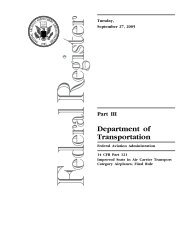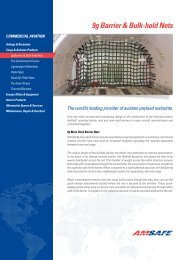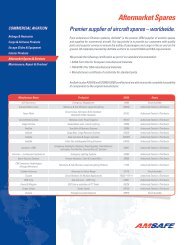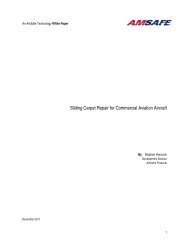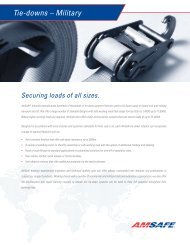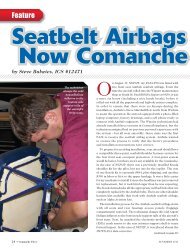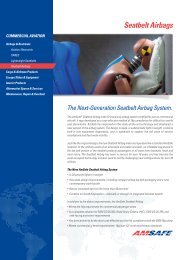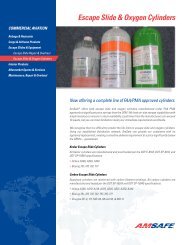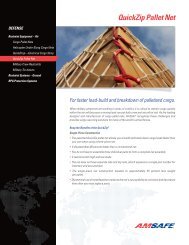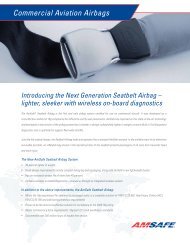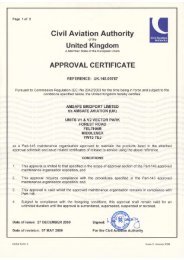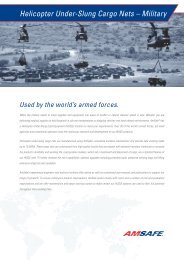Evaluations & Survivability in Fixed Wing Aircraft - AmSafe
Evaluations & Survivability in Fixed Wing Aircraft - AmSafe
Evaluations & Survivability in Fixed Wing Aircraft - AmSafe
Create successful ePaper yourself
Turn your PDF publications into a flip-book with our unique Google optimized e-Paper software.
<strong>Evaluations</strong> and <strong>Survivability</strong> of Inflatable Restra<strong>in</strong>t Systems<br />
<strong>in</strong> Small <strong>Fixed</strong> W<strong>in</strong>g <strong>Aircraft</strong><br />
Thomas Barth, Technical Director<br />
AMSAFE Aviation Inflatable Restra<strong>in</strong>ts<br />
5456 E. McDowell Rd., Suite 101<br />
Mesa, AZ 85215<br />
ABSTRACT<br />
This paper evaluates aircraft impact survivability based<br />
on a literature review and dynamic impact tests.<br />
Commercial aircraft are considered, but the focus is small<br />
fixed w<strong>in</strong>g and General Aviation (GA) aircraft. Aortic<br />
<strong>in</strong>jury is evaluated as it relates to the aircraft impact<br />
environment. Dynamic tests us<strong>in</strong>g standard and the<br />
<strong>AmSafe</strong> Aviation Inflatable Restra<strong>in</strong>t (AAIR) are<br />
evaluated. The results are presented with the objectives<br />
of ga<strong>in</strong><strong>in</strong>g perspective, draw<strong>in</strong>g conclusions, and mak<strong>in</strong>g<br />
recommendations for improved survivability.<br />
INTRODUCTION<br />
<strong>Aircraft</strong> cab<strong>in</strong> safety has improved s<strong>in</strong>ce the <strong>in</strong>troduction<br />
of new safety regulations <strong>in</strong> 1988. New seat structures<br />
are certified us<strong>in</strong>g dynamic impacts with some basic<br />
<strong>in</strong>jury measures <strong>in</strong>cluded.* The full benefit of these<br />
changes have not been fully realized due to issues which<br />
have yet to be addressed. These <strong>in</strong>clude retrofit of older<br />
aircraft and full compliance to <strong>in</strong>jury requirements.**<br />
Improved crashworth<strong>in</strong>ess raises the survivability<br />
threshold and ultimately causes accelerative/<strong>in</strong>ertial<br />
<strong>in</strong>juries to play a larger role. These <strong>in</strong>juries are caused by<br />
the <strong>in</strong>ertial movement of body tissues, when the impact<br />
force is well distributed to the body. The other type of<br />
<strong>in</strong>jury is referred to as “contact” or force based. These<br />
occur usually from excessive occupant flail<strong>in</strong>g, and direct<br />
forces cause localized trauma. The widespread use of<br />
automotive air bags provides a good example of how<br />
improved restra<strong>in</strong>t changed survivability environment.<br />
*Federal Aviation Regulation (FAR) 25.562 (Transport<br />
Category) and 23.562 (General Aviation) added dynamic<br />
performance criteria for aircraft seat systems.<br />
**The “Retrofit Rule” was published <strong>in</strong> the Federal<br />
Register on September 27 th , 2005 (Docket No. FAA-<br />
2002-13464-2; Amendment No. 121-315).<br />
Air Bags have mitigated blunt trauma to the head and<br />
chest mak<strong>in</strong>g higher energy impacts survivable. Priorities<br />
<strong>in</strong> automotive safety are shift<strong>in</strong>g toward non-penetrat<strong>in</strong>g<br />
organ <strong>in</strong>jury (accelerative) and lower leg fractures<br />
(contact).<br />
Trends <strong>in</strong> aviation show <strong>in</strong>creas<strong>in</strong>g use of smaller airports<br />
and smaller aircraft as well as the <strong>in</strong>troduction of more<br />
sophisticated seats and safety technology such as the<br />
Ballistic Recovery System and the <strong>AmSafe</strong> Aviation<br />
Inflatable Restra<strong>in</strong>t. All of these factors are affect<strong>in</strong>g the<br />
survivability threshold as well as public perception of<br />
safety. This is particularly true for small aircraft, which<br />
have the highest accident occurrence and fatality rate.<br />
A study of the survivability environment for aircraft is<br />
presented with a focus on small fixed w<strong>in</strong>g aircraft. A<br />
literature study and an evaluation of dynamic impact tests<br />
are <strong>in</strong>cluded.<br />
AIRCRAFT ACCIDENT STUDIES<br />
Immediately apparent is a disparity between the<br />
survivability of commercial (part 121) and GA (Part 91<br />
and 135) accidents. One study based on data from 1984<br />
to 1996 notes the GA accident rate as 32 times that of<br />
commercial aircraft, and a fatality rate of 22% compared<br />
with 4% for commercial operations. (Li 1999) More<br />
recent NTSB statistics <strong>in</strong>dicate a grow<strong>in</strong>g disparity due to<br />
the drop <strong>in</strong> commercial accident rate. Major commercial<br />
aircraft accidents per million flight hours dropped from<br />
0.40 (average from 1984 to 1996) to 0.12 (average from<br />
1997 to 2004), about 56 times that of GA. The year 2004<br />
had 14 commercial fatalities while there were 556 GA<br />
fatalities. (NTSB, 2005)<br />
The distribution of <strong>in</strong>jury <strong>in</strong> fatal GA accidents <strong>in</strong>dicates<br />
the importance of the head and neck, but also of the<br />
thoracic region as illustrated <strong>in</strong> figure 1. (Chalmers 2000,<br />
Kirkham 1982, Wiegmann 2003)
Percentage Percentage of Autopsies of Injuries with Injury<br />
80<br />
70<br />
60<br />
50<br />
40<br />
30<br />
20<br />
10<br />
0<br />
General Aviation Fatality Injuries<br />
Head, Neck<br />
Skull Frac.<br />
Aorta<br />
Heart<br />
Lung<br />
Rib Frac.<br />
Sternum<br />
Cervical<br />
Thorax<br />
Abdomen<br />
Kidney<br />
Liver<br />
Pelvic<br />
Spleen<br />
Bladder<br />
Lumbar<br />
Sacral<br />
Upper<br />
Lower<br />
Head Thorax Lower Thorax Extremities<br />
Figure 1. Injury Distribution<br />
Inertial <strong>in</strong>juries to organs (such as heart/aorta, lungs, liver<br />
and spleen), is recognized as a major concern. But the<br />
complexity of the <strong>in</strong>jury mechanisms makes them<br />
difficult to measure and assess. Another issue is the<br />
relatively small amount of GA human factors study.<br />
These events are a much lower priority due to public and<br />
media focus on larger scale events.<br />
The literature study highlighted a problem with aviation<br />
safety. First, Small aircraft are disproportionately unsafe.<br />
Second, the knowledge for improvement is <strong>in</strong>adequate<br />
because the impact environment is not well understood<br />
and human factors <strong>in</strong>vestigations are seldom done. The<br />
technology for a drastic improvement exists, as will be<br />
seen later <strong>in</strong> this paper. Sett<strong>in</strong>g future priorities for<br />
implementation of new technology will require better<br />
understand<strong>in</strong>g of <strong>in</strong>jury thresholds and how they relate to<br />
the impact environment.<br />
Aortic <strong>in</strong>jury was selected for study and prelim<strong>in</strong>ary<br />
f<strong>in</strong>d<strong>in</strong>gs are presented here. It was chosen to learn about<br />
the aviation specific impact environment <strong>in</strong> general, and<br />
because it has good potential for improv<strong>in</strong>g survivability.<br />
Aortic Injury – Indicator of Impact<br />
Aviation crash studies have always shown a high<br />
<strong>in</strong>cidence of aortic <strong>in</strong>jury, but the threshold and design<br />
limits have never been established. The aortic <strong>in</strong>jury<br />
mechanism is related to the impact vector, and thus is a<br />
key to understand<strong>in</strong>g the event and estimate potential for<br />
other organ or visco-elastic <strong>in</strong>juries.<br />
Aortic <strong>in</strong>jury often results from the comb<strong>in</strong>ed effects of<br />
direct chest compression and acceleration factors. A<br />
consensus on the more complicated circumstances has not<br />
been established. However, basic trends with respect to<br />
acceleration are evident. Non-penetrat<strong>in</strong>g trauma is<br />
associated with stress <strong>in</strong>duced by <strong>in</strong>ertial displacement of<br />
the heart, aortic arch, or abdomen. <strong>Aircraft</strong> have a<br />
significant downward impact vector as compared to<br />
longitud<strong>in</strong>al impacts found <strong>in</strong> automotive. This can been<br />
seen <strong>in</strong> the distribution of <strong>in</strong>jury location on the aorta. Up<br />
to 85% of automotive cases are attributed to the “classic<br />
site”. (Dolney, 1978) This is the descend<strong>in</strong>g thoracic aorta<br />
isthmus (arch), near the attachment of the ligamentum<br />
arteriosum. Longitud<strong>in</strong>al impacts cause the arch to move<br />
forward, <strong>in</strong>duc<strong>in</strong>g stress at the ligament, which is fixed to<br />
the pulmonary wall. A survey of automotive case studies<br />
yields an approximate distribution as shown <strong>in</strong> figure 2.<br />
(Allmendiger 1977, Beall 1969, Degiannis 2003, Dolney<br />
1978, Kosak 1971, Marsh 1957, Mure 1990, Parmerly<br />
1958, Roughneen 1995, Seil<strong>in</strong>g 1975, Sevitt 1977,<br />
Warrian 1988)<br />
Abdomen<br />
Trace<br />
Other<br />
15%<br />
Other<br />
28%<br />
Abdomen<br />
14%<br />
Classic<br />
67%<br />
Ascend<strong>in</strong>g<br />
18%<br />
Figure 2. Aortic Injury Distribution, Automotive Autopsy<br />
Aortic Injury - <strong>Aircraft</strong> Environment<br />
The aircraft environment has a very different distribution<br />
as shown <strong>in</strong> Figure 3. (Gable 1963) The ascend<strong>in</strong>g and<br />
abdom<strong>in</strong>al aorta locations are most frequent. Injury <strong>in</strong><br />
these locations is associated with vertical displacement of<br />
the heart or abdomen, stress<strong>in</strong>g the <strong>in</strong>terface between the<br />
organ and the aorta.<br />
Ascend<strong>in</strong>g<br />
31%<br />
Classic<br />
20%<br />
Figure 3. Aortic Injury Distribution, GA <strong>Aircraft</strong> Autopsy<br />
One may expect all aortic <strong>in</strong>jury to be non-survivable, but<br />
a significant m<strong>in</strong>or percentage do survive. Partial tears to<br />
one or more of the three layers compris<strong>in</strong>g the aorta will<br />
often result <strong>in</strong> an aneurysm. Surpris<strong>in</strong>gly, timely and
accurate diagnosis rather than extent of damage appear to<br />
be primary for survivability. Survival rate at the scene<br />
ranges from about 10% to 20% percent (Beal 1969), and<br />
up to about 30%, with 60 to 70% successfully repaired.<br />
(Creasy 1997) Case studies with successful repair of<br />
complete trans-section can also be found, <strong>in</strong>clud<strong>in</strong>g<br />
Parmerly, who noted 9 of 38 survivor cases had complete<br />
trans-section. (Beal 1969, Parmerly 1958)<br />
<strong>Survivability</strong> Threshold and Injury Tolerance<br />
Understand<strong>in</strong>g the basic relationship between impact load<br />
and <strong>in</strong>jury tolerance is critical for evaluat<strong>in</strong>g survivability.<br />
A simple spr<strong>in</strong>g analogy and the criterion developed for<br />
sp<strong>in</strong>al <strong>in</strong>jury provides a good means to illustrate <strong>in</strong>jury<br />
tolerance. <strong>Aircraft</strong> safety regulations <strong>in</strong>clude a lumbar<br />
sp<strong>in</strong>e compressive load limit criterion of 1500 lb (7 KN).<br />
Figure 4 illustrates <strong>in</strong>jury tolerance limits by graphically<br />
depict<strong>in</strong>g the fracture threshold of a simple spr<strong>in</strong>g on a<br />
logarithmic chart of the load.<br />
Log<br />
Peak<br />
Accel.<br />
Log Pulse Duration<br />
Figure 4. Fracture Threshold, Long Duration Pulse<br />
The threshold above is flat because the onset rate does not<br />
affect the response. The load is essentially a step function<br />
with <strong>in</strong>f<strong>in</strong>ite energy. Now consider shorter impact pulses,<br />
whose duration is similar to the natural period of the<br />
spr<strong>in</strong>g. The rate of load<strong>in</strong>g and total energy of these<br />
pulses will have an affect on the shape of the fracture<br />
threshold. Figure 5 shows the velocity change doma<strong>in</strong>.<br />
Log<br />
Peak<br />
Accel.<br />
(figure 5 looks at this region)<br />
Not Failed<br />
∆ V critical<br />
(pulse > nat. freq.)<br />
Failure<br />
peak G critical<br />
(pulse >> nat. freq.)<br />
Log Pulse Duration<br />
Figure 5. Fracture Threshold, Short Duration Pulse<br />
The slope of the ∆ V portion is a function of the onset<br />
rate. The max slope will be for a square pulse, which has<br />
a dynamic overshoot equal to twice the peak for an undamped<br />
structure. Increased damp<strong>in</strong>g will decrease the<br />
slope. A critically damped system becomes a flat l<strong>in</strong>e<br />
with zero overshoot. (Craig 1981)<br />
The spr<strong>in</strong>g analogy can be applied to virtually all<br />
measures of <strong>in</strong>jury potential. The lumbar criterion is<br />
based on the Dynamic Response Index (DRI). DRI is<br />
def<strong>in</strong>ed as the peak amplitude of the impact pulse divided<br />
by the weight of the occupant. (Stech 1969) This peak<br />
value is force based, <strong>in</strong>dicat<strong>in</strong>g that the sp<strong>in</strong>e is stiff and<br />
has a short natural frequency relative to the impact pulses<br />
considered.<br />
Each body tissue will have a unique tolerance curve. It is<br />
unknown the extent that the lumbar design requirement<br />
mitigates aortic <strong>in</strong>jury. The aortic <strong>in</strong>jury tolerance curve<br />
has yet to be estimated. Differences <strong>in</strong> seat, restra<strong>in</strong>t and<br />
aircraft factors will affect the potential for a clear<br />
estimation of this tolerance curve. Although these types<br />
of factors were able to be overcome with DRI, which was<br />
orig<strong>in</strong>ally developed for sp<strong>in</strong>al tolerance to ejection seats<br />
with rocket catapults. (Lobdell 1972) Improved<br />
capability of computers to model visco-elastic materials<br />
and work develop<strong>in</strong>g detailed f<strong>in</strong>ite element models of the<br />
aorta provide valuable tools. (Shah 2001)<br />
Evidence exists suggest<strong>in</strong>g that at least a portion of the<br />
aorta <strong>in</strong>jury tolerance curve is with<strong>in</strong> the survivable<br />
doma<strong>in</strong>. Occupants of small aircraft are more susceptible<br />
to acceleration <strong>in</strong>jury than those <strong>in</strong> large aircraft. Less<br />
crushable structure transmits the impact pulse more<br />
directly to the occupants. However, aortic <strong>in</strong>jury has been<br />
found even <strong>in</strong> survivable large transport aircraft crashes<br />
(Pezzella 1996). It should also be noted that factors such<br />
as age and calcification of the arteries negatively affect<br />
the <strong>in</strong>jury threshold.<br />
DYNAMIC IMPACT TESTS<br />
The literature and <strong>in</strong>jury study <strong>in</strong> the previous sections<br />
<strong>in</strong>dicate benefits from learn<strong>in</strong>g about the downward<br />
impact environment associated with aircraft. Until more<br />
<strong>in</strong>formation is developed, this case is established only for<br />
the lumbar sp<strong>in</strong>e. In order to evaluate a larger variety of<br />
contact and energy based potential <strong>in</strong>jury, impact tests <strong>in</strong><br />
the longitud<strong>in</strong>al direction were evaluated.<br />
Several dynamic sled tests were conducted at the <strong>AmSafe</strong><br />
Aviation Impact Dynamics Laboratory <strong>in</strong> Phoenix<br />
Arizona. Generic rigid seats with either standard or<br />
airbag restra<strong>in</strong>t systems were used. Generic<br />
configurations provide a means to evaluate energy
transfer and <strong>in</strong>jury potential while m<strong>in</strong>imiz<strong>in</strong>g the effect<br />
from <strong>in</strong>stallation specific factors. Complete test reports<br />
are filed at the laboratory accord<strong>in</strong>g to the <strong>AmSafe</strong><br />
Sequence Numbers: F0115 (Forward); F0252, F0270,<br />
F0272 (Side Fac<strong>in</strong>g).<br />
The performance measures evaluated do not always<br />
match those currently part of the Federal Aviation<br />
Regulations (FAR). The tests are development <strong>in</strong> nature<br />
and measures used are selected to best illustrate <strong>in</strong>jury<br />
trends rather than show compliance to a requirement.<br />
Results – Forward Fac<strong>in</strong>g Seat<br />
Figures 6 and 7 show a forward fac<strong>in</strong>g, longitud<strong>in</strong>al<br />
dynamic test with an impact pulse of 21 g over 140ms and<br />
a total velocity change of 42 ft/s. The high speed video<br />
images are taken at the time of peak web load (85ms) and<br />
the maximum flail<strong>in</strong>g (150ms) respectively. The left<br />
ATD (when viewed from the top) is fitted with a four<br />
po<strong>in</strong>t AAIR restra<strong>in</strong>t. The right ATD is fitted with a<br />
standard four po<strong>in</strong>t restra<strong>in</strong>t.<br />
Figure 7. Forward Impact at Time = 150ms<br />
This test illustrates the energy management of the<br />
occupants dur<strong>in</strong>g an impact. Mitigat<strong>in</strong>g contact <strong>in</strong>jury<br />
from secondary impacts to <strong>in</strong>terior structure requires less<br />
occupant flail<strong>in</strong>g. The AAIR restra<strong>in</strong>t shows this affect,<br />
with the occupant more directly coupled to the seat.<br />
Figure 8. Forward Impact Test Web Loads<br />
Results – Side Fac<strong>in</strong>g Seat, Pelvic/Rib Evaluation<br />
Three side fac<strong>in</strong>g seat tests are evaluated. The occupants<br />
are exposed to the regulatory standard 16g pulse with a<br />
duration of 180ms and a total velocity change of 44 ft/s.<br />
The tests have the configurations shown <strong>in</strong> Table 1.<br />
Figure 6. Forward Impact at Time = 85ms<br />
The impact energy is transferred over a larger period of<br />
time and at lower peak accelerations. This is evident <strong>in</strong><br />
the web loads as shown <strong>in</strong> figure 8. The position of the<br />
ATD’s look about the same at 85ms, but the energy<br />
transfer to the occupant has begun to occur earlier with<br />
the AAIR. This is evident <strong>in</strong> the web loads and ultimately<br />
<strong>in</strong> the view at 150ms. The ATD without the AAIR has<br />
significantly more flail<strong>in</strong>g and forward excursion,<br />
<strong>in</strong>creas<strong>in</strong>g the potential for secondary impact to the<br />
<strong>in</strong>terior.<br />
Table 1. Side Fac<strong>in</strong>g Test Configurations<br />
Center Position Armrest Position Both Occupied<br />
3 Po<strong>in</strong>t Std<br />
Restra<strong>in</strong>t<br />
3 Po<strong>in</strong>t Std<br />
Restra<strong>in</strong>t<br />
3 Po<strong>in</strong>t AAIR<br />
Restra<strong>in</strong>ts<br />
Hybrid III ATD ES1 ATD Hybrid III (Cntr)<br />
ES1 (Armrest)<br />
The first evaluation is at the po<strong>in</strong>t of peak pelvic<br />
acceleration, about 85ms <strong>in</strong>to the event as shown <strong>in</strong><br />
Figures 9, 10, and 11. The figures are shown at this time<br />
to illustrate the potential <strong>in</strong>jury associated with the<br />
acceleration based pelvic <strong>in</strong>jury criteria. This criterion<br />
has a threshold limit value of 130g.
Figure 9. Center Seat<br />
Figure 10. Armrest Seat<br />
(at Time = 100ms, maximum pelvic acceleration)<br />
Figure 12. Side Impact Pelvic Acceleration versus Time<br />
The side impact tests show significant <strong>in</strong>trusion of the<br />
armrest for the adjacent seat position. This is a classic<br />
contact type <strong>in</strong>jury. Side impact ATD’s have the<br />
capability to measure rib deflection. The generally<br />
accepted threshold for <strong>in</strong>jury is 1.6 <strong>in</strong> (42mm). (Lankarani<br />
1999) Another potential measure for this <strong>in</strong>jury is the<br />
pubic symphysis force, with a limit criteria of 2,250 lb (10<br />
KN). Both rib deflection and pubic force are under<br />
consideration by the FAA as appropriate <strong>in</strong>jury criteria for<br />
side fac<strong>in</strong>g aircraft seats. Development work is <strong>in</strong><br />
progress to ref<strong>in</strong>e these measurements, and f<strong>in</strong>d<strong>in</strong>gs will<br />
be published <strong>in</strong> future publications.<br />
Figure 11. Both Seats Occupied, AAIR Restra<strong>in</strong>t,<br />
Time = 100ms<br />
Figure 12 provides the Pelvic acceleration versus time for<br />
all the ATD’s <strong>in</strong> these three tests. The scale extends to<br />
the limit value of + or – 130g. The response is well below<br />
the limit criterion, <strong>in</strong>dicat<strong>in</strong>g that either the event is not<br />
<strong>in</strong>jurious, or that the response measured is not appropriate<br />
for the <strong>in</strong>jury mechanism. Aviation regulations have not<br />
def<strong>in</strong>ed the <strong>in</strong>jury requirements for side fac<strong>in</strong>g aircraft<br />
seats. The compliance criteria are established through the<br />
FAA Issue Paper process. Pelvic acceleration, Head<br />
Injury Criteria (HIC), and the Thoracic Trauma Index<br />
(TTI) are the common compliance measures used. HIC<br />
and TTI are evaluated <strong>in</strong> subsequent sections.<br />
Results – Side Fac<strong>in</strong>g Seat, Thoracic Trauma Index<br />
Another acceleration based response is the Thoracic<br />
Trauma Index (TTI) with a limit value of 85g. This<br />
response is an acceleration based <strong>in</strong>dex us<strong>in</strong>g the average<br />
of the peak acceleration of the lower sp<strong>in</strong>e (measured at<br />
T12) and the peak rib acceleration. The AAIR restra<strong>in</strong>t<br />
produced a large reduction <strong>in</strong> TTI as shown <strong>in</strong> Table 2,<br />
although both were below the limit of 85g.<br />
Table 2. TTI and Related Responses<br />
Side Fac<strong>in</strong>g Impact Tests, ES1 ATD’s<br />
Response<br />
Armrest<br />
Std 3 Po<strong>in</strong>t<br />
Armrest<br />
AAIR<br />
ES1 ES1<br />
TTI 52g 29g<br />
Peak Acceleration Rib 63g 30g<br />
Peak Acceleration T12 42g 27g<br />
The T12 acceleration versus time provides a useful<br />
<strong>in</strong>dication of the torso acceleration compar<strong>in</strong>g the<br />
standard and AAIR restra<strong>in</strong>ts. Figure 13 provides the T12<br />
acceleration versus time for the ES1 ATDs.
Figure 13. T12 Acceleration vs Time, with and without<br />
AAIR Restra<strong>in</strong>t.<br />
Figure 15. Armrest Seat, Std Restra<strong>in</strong>t at 150ms<br />
The thoracic region is difficult to assess directly from the<br />
high speed video. Similar to the web loads seen <strong>in</strong> the<br />
forward test, earlier <strong>in</strong>teraction of the AAIR and more<br />
distributed load<strong>in</strong>g to the occupant are evident.<br />
Results – Side Fac<strong>in</strong>g Seat, Head and Neck<br />
The Pelvic/Rib/Thorax evaluations are critical mid-event.<br />
The other critical po<strong>in</strong>t is late <strong>in</strong> the event, dur<strong>in</strong>g<br />
maximum flail<strong>in</strong>g. This occurs at about 150 ms with the<br />
standard restra<strong>in</strong>t and about 140ms for the airbag<br />
restra<strong>in</strong>t. Figures 14, 15 and 16 show the three tests at<br />
150ms.<br />
Figure 16. Both Seats, AAIR Restra<strong>in</strong>t, at 150ms<br />
The images at 150ms of the tests us<strong>in</strong>g standard restra<strong>in</strong>ts<br />
clearly show severe <strong>in</strong>jury potential to the head and neck.<br />
The flail<strong>in</strong>g of the head is extreme. Visual evaluation of<br />
the AAIR restra<strong>in</strong>ed occupants show drastic<br />
improvement.<br />
Figure 14. Center Seat, Std Restra<strong>in</strong>t at 150ms<br />
HIC exhibited a massive difference between the standard<br />
and AAIR restra<strong>in</strong>t as shown <strong>in</strong> Table 3. HIC is based on<br />
a calculation of the head resultant acceleration. A<br />
formula is used which establishes an average acceleration<br />
over a critical time <strong>in</strong>terval (Delta T). Thus both<br />
acceleration and the energy associated with the impact of<br />
the head affect the f<strong>in</strong>al result. In this way, HIC<br />
addresses both contact and <strong>in</strong>ertial <strong>in</strong>jury. Short duration,<br />
high g impacts are associated with skull fracture, while<br />
longer duration, lower g impacts are associated with bra<strong>in</strong><br />
<strong>in</strong>jury. Note that the applicable impact durations are
Acceleration (g)<br />
debated, with a maximum of 36ms at 1000 or 15ms at 700<br />
commonly accepted.<br />
Table 3. HIC and Related Responses<br />
Side Fac<strong>in</strong>g Impact Tests<br />
Response Center<br />
Std 3 Pnt<br />
Armrest<br />
Std 3 Pnt<br />
Center<br />
AAIR<br />
Armrest<br />
AAIR<br />
Hybrid III ES1 Hyb. III ES1<br />
HIC 1260 736 194 206<br />
Peak Acc. 93g 64g 29g 32g<br />
Time Pk 141 138ms 104ms 92ms<br />
Delta T 40ms 53ms 113ms 119ms<br />
Compar<strong>in</strong>g the head resultant acceleration also<br />
dramatically illustrates the effect of the AAIR restra<strong>in</strong>t as<br />
shown <strong>in</strong> figure 17. The AAIR restra<strong>in</strong>ed occupants show<br />
significant deceleration of the head around 50ms as<br />
opposed to the standard restra<strong>in</strong>t, at about 80ms. This<br />
creates a broad, flat acceleration profile with peak values<br />
a fraction of the spike seen with the standard restra<strong>in</strong>t.<br />
100<br />
80<br />
60<br />
40<br />
20<br />
Head Resultant Acceleration<br />
Comparison of Std and AAIR Restra<strong>in</strong>t<br />
Standard, H3<br />
Standard, ES1<br />
AAIR, H3<br />
AAIR, ES1<br />
0<br />
0 0.02 0.04 0.06 0.08 0.1 0.12 0.14 0.16 0.18 0.2<br />
Time (s)<br />
Figure 17. Head Resultant Accel., Side Fac<strong>in</strong>g Seats<br />
The high acceleration peaks occurr<strong>in</strong>g at about 150ms for<br />
the standard restra<strong>in</strong>ts also <strong>in</strong>dicate a critical problem with<br />
the neck. The peak head acceleration is very different<br />
from the torso, whose peak occurred at about 120ms (see<br />
figure 13). This difference <strong>in</strong> relative motion is reacted<br />
through load<strong>in</strong>g of the neck. The neck loads for the<br />
AAIR restra<strong>in</strong>t are a fraction of that for the standard<br />
restra<strong>in</strong>t. The Neck loads for these tests are not presented<br />
due to bio-fidelity issues between the ATD types. An<br />
accurate assessment of the neck loads to evolv<strong>in</strong>g limit<br />
criteria is be<strong>in</strong>g developed, and will be presented <strong>in</strong> future<br />
publications.<br />
CONCLUSIONS and RECOMMENDATIONS<br />
Published accident analysis and other literature related to<br />
the survivability of transport and General Aviation<br />
aircraft <strong>in</strong>dicate the problems and opportunities for<br />
improved survivability <strong>in</strong> small aircraft. The technology<br />
exits to achieve drastic improvements. Resource<br />
priorities should focus on mak<strong>in</strong>g these aircraft more<br />
survivable. This will address the disparity between the<br />
small and large aircraft and benefit aviation safety <strong>in</strong><br />
general.<br />
Study of the distribution of <strong>in</strong>juries <strong>in</strong> GA aircraft and the<br />
impact environment <strong>in</strong>dicate the importance of aircraft<br />
specific research. The study also shows that<br />
acceleration/energy based <strong>in</strong>jury <strong>in</strong> aircraft are relatively<br />
poorly understood as compared to the current state of<br />
technology and design. The frequency of human factors<br />
<strong>in</strong>vestigation of small aircraft accidents is <strong>in</strong>adequate.<br />
A better understand<strong>in</strong>g of the aircraft specific<br />
environment should be developed. This knowledge will<br />
be needed to support the trend towards smaller aircraft<br />
operations.<br />
The aortic <strong>in</strong>jury study and the dynamic test evaluations<br />
expose specific concerns and potential benefits for <strong>in</strong>jury<br />
mitigation. In the case of aortic <strong>in</strong>jury, which is<br />
representative of energy based <strong>in</strong>jury to the body, <strong>in</strong>jury<br />
thresholds and potential benefits need to be further<br />
developed before conclusive recommendations can be<br />
drawn. But <strong>in</strong> the case of many force based <strong>in</strong>jury, such<br />
as neck, ribs, and lower thorax, sufficient understand<strong>in</strong>g<br />
exists to standardize performance measures and develop a<br />
plan for implementation. The tests also showed that<br />
impact survivability can greatly benefit from <strong>in</strong>flatable<br />
restra<strong>in</strong>t technology.<br />
REFERENCES<br />
Allmendiger P.D., Low H.B.C., Takata H., Ellison L.H.,<br />
et all; Deceleration Injury: Laceration of the Thoracic<br />
Aorta; American Journal of Surgery, Volume 133, No. 4,<br />
Pg 490-491; April 1977.<br />
Beall A.C., Arbegast N. R., Ripepi A. C., Bricker D. L., et<br />
all; Aortic Laceration Due to Rapid Deceleration; Arch<br />
Surgery, Volume 98, No. 5, pg 595-601; May 1969<br />
Biodynamics Database, United States Wright Paterson<br />
Air Force Base, www.biodynwpafb.mil.af<br />
Chalmers D.J., O’Hare D. P., McBride D. I.; The<br />
Incidence, Nature, and Severity of Injuries <strong>in</strong> New<br />
Zealand Civil Aviation. Aviation, Space, and<br />
Environmental Medic<strong>in</strong>e, Vol. 71, No. 4. April 2000
Graig R. L., Structural Dynamics, An Introduction to<br />
Computer Methods. John Wiley & Sons, Inc., 1981.<br />
Creasy J. D., Chiles C., Routh W. D., Dyer D.B.;<br />
Overview of Traumatic Injury of the Thoracic Aorta;<br />
Radiographics, Volume 17, No. 1, pg 27 – 45; 1997.<br />
Degiannis E., Bowley D., Smith M.D.; New Concepts <strong>in</strong><br />
Blunt Injury of the Thoracic Aorta; South African journal<br />
of Science, Volume 41, No. 3, August 2003.<br />
Dolney J., German J.D., Zeff R. H., Phillips S.J., et all;<br />
Deceleration Injuries of the Great Vessels; Journal of<br />
Iowa Medical Association, Volume 68, No. 5, pg 163-<br />
165; May 1978.<br />
Gable W.D., Townsend F. M.; An Analysis of<br />
Cardiovascular Injuries Result<strong>in</strong>g From Acceleration<br />
Force; Aerospace Med., No 34, pg 929-934; Oct. 1963.<br />
Kirkham, W. R., Wicks S. M., Lowrey D. L.;<br />
Crashworth<strong>in</strong>ess Studies: Cab<strong>in</strong>, Seat, Restra<strong>in</strong>t, and<br />
Injury F<strong>in</strong>d<strong>in</strong>gs In Selected General Aviation Accident.<br />
FAA Civil Aeromedical Institute, Report No. FAA-AM-<br />
82-7, March 1982.<br />
Kosak M.; Traumatic rupture of the thoracic aorta caused<br />
by deceleration; Journal of cardiovascular Surgery,<br />
Volume 12, No 2, pg 131-139; Mar-Apr 1971.<br />
Lankarani H. M., Gowdy V., DeWeese R., Kishore P.<br />
Murthy A., Compliance Criteria For Side Fac<strong>in</strong>g <strong>Aircraft</strong><br />
Seats. SAE Paper 1999-01-1598, April 1999.<br />
Li G., Baker S. P.; Correlates of Pilot Fatality <strong>in</strong> General<br />
Aviation Crashes. Aviation, Space, and Environmental<br />
Medic<strong>in</strong>e, Vol. 70, No. 4, April 1999.<br />
Lobdell T.E., Kroell C. K., Schneider D. C., Her<strong>in</strong>g W.<br />
E., Nahum A. M., Impact Response of the Human<br />
Thorax, Part III – Mathematical Model for Thoracic<br />
Impact. Symposium of Human Impact Response,<br />
Measurement and Simulation, 1972.<br />
Marsh C.L., Moore R. C.; Deceleration Trauma;<br />
American Journal of Surgery, Volume 93, pg 623-631;<br />
April 1957.<br />
McMeek<strong>in</strong> R. R.; Patterns of Injury <strong>in</strong> Fatal <strong>Aircraft</strong><br />
Accident; Aerospace Pathology, Chapter 10, pg 86-95,<br />
College of American Pathologists Foundation; 1975.<br />
Mure A.J., Unkle D. W., Dool<strong>in</strong> E., Ross S. E.; Blunt<br />
Aortic Truama follow<strong>in</strong>g deceleration <strong>in</strong> a seven year old;<br />
Pediatric Emergency Care, Vol 6, No 2, pg 104-105; June<br />
1990.<br />
National Transportation Safety Board. Aviation Accident<br />
Statistics. www.ntsb.gov/aviation/Stats.htm, 2005<br />
Parmerly, M.C., Matt<strong>in</strong>gly T.W., Manion W. C., Jahnke<br />
E. J.; Nonpenetrat<strong>in</strong>g Traumatic Injury of the Aora,<br />
Circulation, Volume 17, pg 1086 – 1101, June 1953.<br />
Pezzella T.A.; Blunt Traumatic Injury of the Thoracic<br />
Aorta Follow<strong>in</strong>g Commercial Airl<strong>in</strong>e Crashes; Texas<br />
Heart Inst. Journal, Volume 23, No. 1, pg 65-67; 1996.<br />
Roughneen P. T., Cortelli M, Potts J; Sub<strong>in</strong>timal<br />
Hematoma of the Aorta after Deceleration Injury; Case<br />
Reports, Dept of Surgery, Div of Thoracic and<br />
Cardiovascular Surgery, University of Texas Medical<br />
School at Houston Texas, Volume 22 No 3, 1995.<br />
Seil<strong>in</strong>g A., Peters H.; Life Threaten<strong>in</strong>g Intrathoracic<br />
Injuries Due to Indirect Force, Deceleration Injury; Hefte<br />
Unfallheilkd, 121, pg 235-237; 1975<br />
Sevitt S; The Mechanisms of Traumatic Ruture of the<br />
Thoracic Aorta; British Journal of Surgery, Vol 64, 166-<br />
173; 1977.<br />
Shah C. S., Yang K. H., Hardy W., Wang H. K., K<strong>in</strong>g, A.<br />
I., Development of a Computer Model to Predict Aortic<br />
Rupture Due to Impact Load<strong>in</strong>g. SAE Paper 2001-22-<br />
0007, 2001<br />
Warrian K. R., Shoenut J. P., Iannicello C. M., Gyan S.<br />
P., et all; Seatbelt Injury to the Abdom<strong>in</strong>al Aorta; The<br />
Journal of Trauma, Volume 28, No. 10, pg 1505-1507;<br />
October 1988.<br />
Wiegmann D. A., Taneja N.; Analysis of Injuries Among<br />
Pilots Involved <strong>in</strong> Fatal General Aviation Airplane<br />
Accidents. Accident Analysis and Prevention, 35, pg<br />
571-577, 2003.<br />
BIOGRAPHIE<br />
T. H. Barth graduated from Colorado State University <strong>in</strong><br />
1989 with a Bachelors <strong>in</strong> Mechanical Eng<strong>in</strong>eer<strong>in</strong>g, and is<br />
currently two years <strong>in</strong>to a PhD by Research at Cranfield<br />
University with the topic of aircraft impact survivability.<br />
He has 15 years experience <strong>in</strong> automotive and aircraft<br />
restra<strong>in</strong>t system development and vehicle crash dynamics.<br />
Past experience <strong>in</strong>cludes positions at TRW Vehicle Safety<br />
Systems <strong>in</strong> Arizona and Munich Germany; Simula Inc <strong>in</strong><br />
Arizona, and <strong>AmSafe</strong> Aviation <strong>in</strong> Arizona and Toulouse<br />
France. He is currently the Director of Research and<br />
Development for Amsafe Aviation Inflatable Restra<strong>in</strong>ts<br />
Division.





